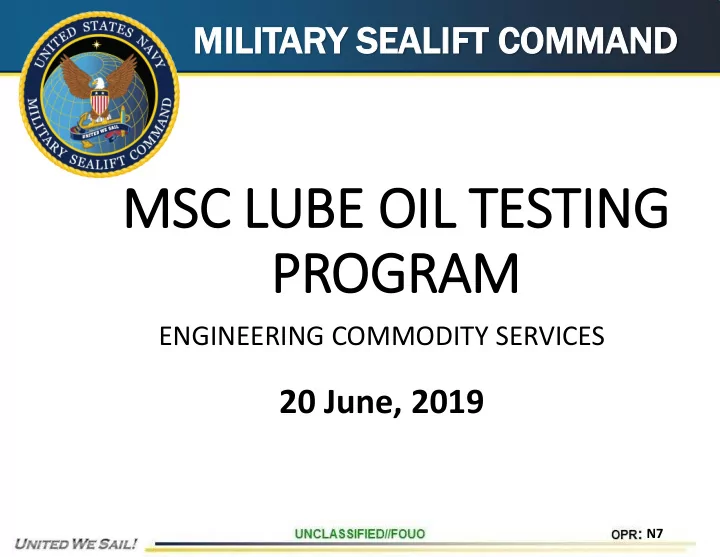

MI MILITARY SE SEALIFT CO COMM MMAND MSC LUB UBE OIL TESTING NG PROGR GRAM ENGINEERING COMMODITY SERVICES 20 June, 2019 N7
THE BEGINNI NING NG ! ! WHY TEST EQUIPMENT OIL? • DETERMINE EFFECTS OF ENVIRONMENTAL CONTAMINATION IN THE OIL • WATER • OXIDATION • ACIDS • COMBUSTION BY-PRODUCTS • WEAR DEBRIS N7
THE BEGINNI NING NG ! ! WHO TESTS THE OIL? • SHIP AND SHORESIDE LABORATORY WHAT TESTS DOES THE SHIP PERFORM AND WHY? • VISCOSITY • WATER • TBN (ALKALINITY RESERVE) • INSOLUBLES • OXIDATION • TOTAL FERROUS WEAR METALS (FWM) N7
SHIPB PBOAR ARD L LO TE TESTI TING • VISCOSITY • KITTEWAKE VISCOMETER OR SIMPLE FLOW STICK • MONITOR DIESEL ENGINE OIL FOR FUEL OIL DILUTION • WATER • SYSTEM COOLING LEAKS, • EXCESSIVE STEAM SEAL LEAKS (MAIN AND AUXILIARY BOILERS) • CONDENSATION • TBN • MEASURE OF ACIDS AFFECTING ALKALINE RESERVE IN ENGINE OIL N7
SHIPB PBOAR ARD L LO TE TESTI TING • INSOLUBLES • MEAURE OF DIRT AND COMBUSTION BY PRODUCTS IN THE OIL • OXIDATION • INDICATION OF THE USEFUL LIFE OF THE OIL • INDICATION OF OIL SHEAR DEGRADATION • FERROUS WEAR METAL MONTORING • WEAR METAL TRENDING TO DETERMINE REAL-TIME FAILURE N7
OFF SHI HIP S P SAMPLES Samples are taken as directed by SAMM or situational conditions • All samples should be taken when the flud is in circulation or no longer than 20 minutes after equipment is shut-down. • Engine and gear oil samples should be taken from the sump via the dipstick or gear sump fill port • Line shaft bearing should be taken from the drain plug • Hydraulic samples should be taken from the sump when the system is energized N7
SHORESIDE CONTRACT LABORATORY The shoreside laboratory receives lube oil samples, performs visual inspection and assigns sample tracking number • Laboratory performs the following tests: • Viscosity (all samples) • Dispersed Water (all samples) • TBN (all engines) • Soot/ Insolubles (all engines) • Flash Test ( If engine oil viscosity fails) • Oxidation (engine, circulating, gear, and hydraulic fluids) N7
LABORATORY TESTS (CONTINUED) • Particle counts (All Hydraulic Fluids) • Total Acid Number (Synthetic, Circulation, and Hydraulic Fluids) • Fuel Dilution by Percentage (Engines only) • PQ Index (All gearboxes and gear assemblies) • Spectrometry (All Equipment) • Analytical Ferrography (Situational) N7
LAB LABORATORY O OUTPU TPUT T PR PROCESS • Daily, laboratory consolidates sample test results and pushes sample report to Emprise Corporation. • Ferrograms are processed in 3-5 days and emailed to MSC Technical Representative. • Tested samples are retained at laboratory for a period of 45 days. N7
MSC LUBE OIL SAMPLE TEST REVIEW 1. Emprise Corporation posts lube oil sample results to the “SEAS PROGRAM” for MSC’s review 2. MSC reviews LO sample test results and provided recommend to Chief Engineer 3. MSC releases LO test result message and the E “SEAS PROGRAM” pushes LO message to the ship via Email. 4. “SEAS PROGRAM” pushes test results with recommendations to the ship’s onboard SAMM data base N7
SHORESIDE LABORATORY TEST SLATES N7
VISCOSITY TESTING Low viscosity might indicate: • Lubricant mixing (incorrect amounts added) • Fuel Dilution • Excessive refrigerant mixing • Base oil cracking from high heat damage High viscosity might indicate: • Lubricant oxidation • Lubricant mixing (incorrect lube added) • Excessive emulsification of water in oil (causes high viscosity) • Serious contaminants in oil (soot, antifreeze, etc.) • Volatilization (long hydrocarbon molecules don’t leave) N7
VISCOSITY N7
VISCOSITY INDEX N7
CLASSIFICATIONS OF WATER CONTAMINATION N7
WATER N7
FUEL D L DILUTI TION N7
TOTAL AL BAS ASE NUMBER ( (TB TBN) • TBN is the amount of alkalinity reserve in the oil. Its purpose is to neutralize the acids formed from combustion by-products and water • TBN applies to gasoline and diesel engine • Lower sulfur fuel has reduced the need for higher TBN oils and the need for changing the sump oil as often • Past years many oils had a TBN of 12-15, today’s engine oils are averaging 8-10 N7
TOTAL ACI CID N D NUMBE BER ( R (TAN) • TAN is monitored in synthetic, hydraulic, and circulation oils such as; Gas Turbines, Hydraulics, Steam Turbine oils, and Synthetic Gear Oils • Water contamination is the biggest factor causing acids to increase in these types of oils N7
SPECTRAL A ANALYSIS N7
WEAR AR METAL E AL ELE LEMENTS N7
WEAR AR METAL E AL ELE LEMENTS N7
FT FT-IR S SPECTRO ROSCO COPY • THIS TECHNOLOGY IS USED TO DETECT AND MEASURE THE FOLLOWING: • SOOT • OXIDATION • NITRO-OXIDATION • GLYCOL • FUEL • WATER CONTAMINATION • SULFATE N7
FT FT-IR S SPECTRO ROSCO COPY N7
PARTICLE C E COUNT NTS Particle Counts are: • Quantitative results • Sensitive to water and gas contamination • Started with Turbines and Hydraulics (clean systems) • Laser based • Used as an indicator to trend abnormal wear N7
PAR ARTI TICLE LE C COUNT T CLAS LASS N7
FERROUS DENSITY B TY BY Y PQ PQ INDEX N7
PQ PQ I INDEX Advantages: • Insensitive to air and water in the lubricant • Easy test, therefore inexpensive • Applicable to dark and heavily contaminated fluids Limitations: • Insensitive to non-magnetic particles • No size breakdown N7
ICP t to P PQ I Index C Crossover er N7
PQ I Index W Wea ear A Analysis N7
Analyt ytical Ferro rogra raphy N7
PQ I PQ INDEX N7
PQ I PQ INDEX N7
PQ I PQ INDEX N7
PQ I PQ INDEX N7
PQ I PQ INDEX N7
PQ I PQ INDEX N7
PQ I PQ INDEX N7
PQ I PQ INDEX N7
PQ I PQ INDEX N7
PQ I PQ INDEX N7
PQ I PQ INDEX N7
PQ I PQ INDEX N7
PQ I PQ INDEX N7
QUEST QUE STION ONS? N7
Recommend
More recommend